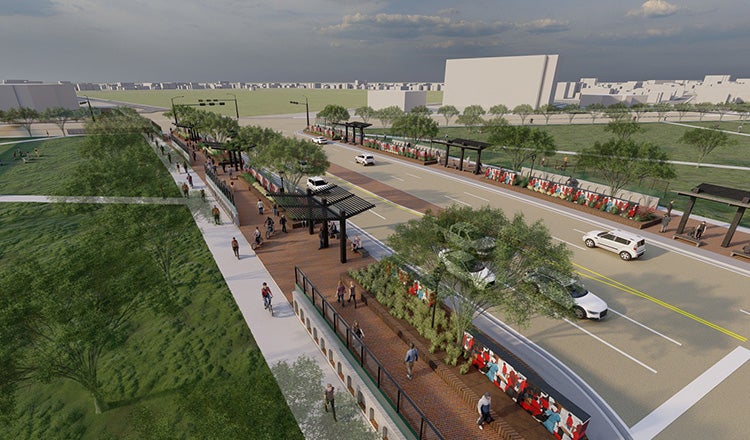I-35 Capital Express Central EIS

I-35 Capital Express Central EIS
Design and Environmental Services for Improved Travel Through Downtown Austin
Interstate 35 has been the north-south backbone of personal, business and freight transportation in Texas since 1962. It is critical to local, state and national security, economic vitality and overall mobility. However, it was constructed nearly 60 years ago under standards that are now outdated. Its congestion is also well known, ranking in Texas’s top five most congested freeways for nearly a decade. Perhaps most importantly, since its completion, it has been a socioeconomic, visual and psychological barrier between east and west Austin.
To remedy this, the Texas Department of Transportation is making improvements to the interstate through the Texas capital in three sections. The $4.5 billion central section, the most complex and expensive, consists of the reconstruction of 8 miles of roadway and bridges, removing the upper decks of the interstate, lowering its profile, adding new lanes and enhancing cross-street bridges.
HDR assisted TxDOT with schematic level design, environmental permitting, right of way, environmental evaluations, and preparation of the draft and final environmental impact statements for this central section. The Final EIS was published in August 2023, marking the completion of one of the fastest EISs in Texas history.
A Rapid and Defensible EIS
The EIS process began in August 2020 when HDR published the notice of intent to develop it and was completed less than three years later. More than 150 HDR staff were involved in the schematic design and completion of the EIS. One of the most high-profile transportation projects in Texas, each public comment period drew thousands of comments. By providing high quality documents, HDR helped expedite this important document.
The interstate cuts through communities with many environmental justice impacts, which were important to mitigate. The public involvement process included extensive efforts to engage with and reach out to traditionally underserved populations. For example, notices and project information was provided in English and Spanish, with Spanish speakers available at all public forums. HDR and TxDOT also developed the CapEx VOICE (Volunteer Opportunity in Community Engagement) working group. Bimonthly listening sessions allowed TxDOT and HDR to delve into community concerns and provided a forum for equity-based outreach to often marginalized community groups.
Major Interstate Profile Changes
The corridor passes through the most urban, dense part of the city, requiring significant redesign of the existing highway. The current interstate uses a double-decked approach that creates a visual and auditory barrier, separating east and west Austin. The re-envisioned interstate will be lowered below ground level for a length of about 5 miles, from Airport Boulevard in the north to Holly Street in the south. Along the corridor, the project will add one general purpose lane and two HOV-managed lanes in each direction. Frontage roads will be moved to ground level above the highway.

Moving the roadway under surface streets rather than above will open new possibilities for connecting neighborhoods on the east and west sides of the interstate, particularly if combined with proposed highway caps. At Airport Boulevard, for instance, a radically different intersection will take the road across I-35 on a huge bridge structure that incorporates enhanced bicycle and pedestrian facilities, green spaces, and a continuous flow intersection to enhance mobility.
Lowering a major interstate is a substantial engineering challenge, however. For example, the Capital Metropolitan Transportation Authority, or CapMetro, has two rail lines that cross the corridor. While they currently cross at-grade, under the existing I-35 mainlanes, lowering the interstate requires adding new bridges for the lines. Drainage and hydraulic design has also been a substantial focus of design work.
The city generally drains water west to east, and lowering I-35 will require creative solutions to manage new drainage requirements. A colossal new drainage tunnel will be bored, for which HDR will provide a variety of design services, including drainage analysis, hydraulics, traffic engineering and more. This 22-foot diameter tunnel will extend nearly 5 miles and be excavated between 60 and 120 feet beneath the city to minimize the impact on surface homes and businesses. It will also be a massive upgrade to the city’s aging and undersized drainage system. While part of the larger I-35 project, the tunnel will be a major project in itself, with an anticipated budget of more than $725 million.
Construction on the I-35 corridor is scheduled to begin in 2024 and is expected to last about 8-10 years.











